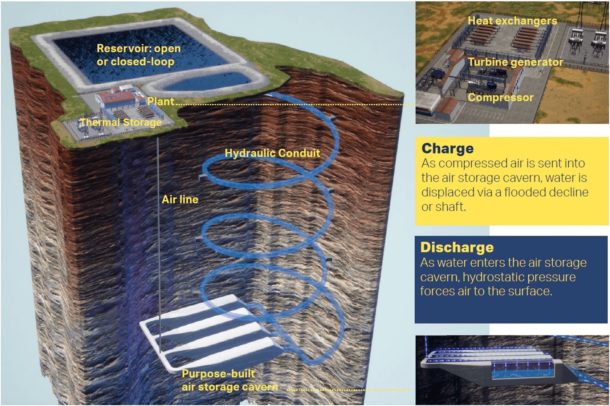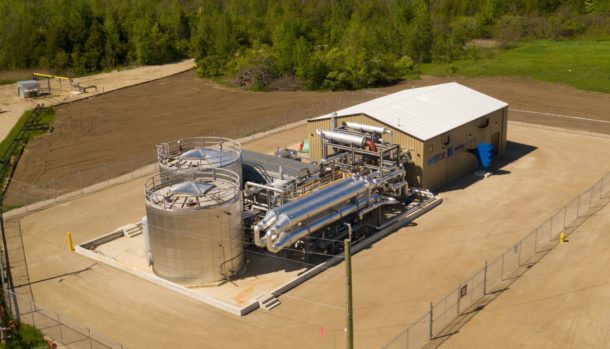It has become commonplace to see and hear about companies and countries “going solar” or committing to obtaining a certain percentage of energy from renewable sources. An encouraging sign, to say the least, but unfortunately, we are still far from being able to entirely shift our power grids over to sources like solar and wind. What happens if the wind does not blow or the sun does not shine for a period of time? The truth is, we still need to rely on a consistent source of energy at least as a backup for disaster situations or periods of energy variability. But fear not, the Candian company Hydrostor has already figured out a way to balance out our energy needs with a cost-effective and renewable energy storage solution.
The Company is a leading developer of Advanced Compressed Air Energy Storage (A-CAES) projects. To try and put it simply, Hydrostor, with the help of quincy air compressor dealers, uses compressed air to run turbines to generate electricity on demand, which is then transferred and used in the energy grid. The technology works by using electricity from the grid to run a compressor, producing heated compressed air. Heat is extracted from the air stream and stored inside a proprietary thermal store preserving the energy for use later in the cycle. Compressed air is then stored in a purpose-built underground cavern, which is kept at a constant pressure using hydrostatic head from a water column. During charging, compressed air displaces water out of the cavern up a water column to a surface reservoir, and during discharge water flows back into the cavern forcing air to the surface under pressure where it is re-heated using the stored heat and then expanded through a turbine to generate electricity on demand. This entire process is non-emitting, is much more cost-effective than batteries at scale with a 50+-year asset life, and is ideally suited to providing the long-duration storage resource necessary for decarbonizing the grid.

The Company is not the only one excited about the idea of zero-emission energy storage. On September 19th, Hydrostor announced the closing of US$37 million (C$49 million) in growth financing. RBC Capital Markets acted as Hydrostor’s advisor on the transaction, which included a combination of equity, debt, project development, and cash commitments, and an asset acquisition. investors in the raise included Elemental Energy, Canoe Financial, ArcTern Ventures, MaRS Catalyst Fund and Lorem Partners. In addition to investing, Baker Hughes, a GE Company (BHGE), and Meridiam, the global developer, asset and fund manager specializing in sustainable infrastructure and energy transition projects, formed strategic partnerships with Hydrostor as a part of the deal.
I caught up with Hydrostor’s CEO, Curtis VanWalleghem, to learn about how Hydrostor got started, the recent capital raise, and their patented process to solve for energy grid intermittency issues. A former engineer and consultant with Deloitte, Curtis has been the Company’s CEO since its inception. He draws on his experience working on a wide variety of energy projects while he was a Corporate Strategy Consultant, which included work on nuclear plants, wind farms, gas refineries, among others.
RELATED ARTICLES:

Silicon Valley Insider: Intellihot, Using AI and NASA Technology to Provide You Hot Water
Curtis explained that while these zero-emission storage projects are large, from one hundred million to five hundred million in capital costs and two years to permit and build the site, they are a very reliable and cost-effective solution that stacks up well against the alternatives. Lithium-Ion batteries have caught on in recent years, but with multiple football fields of them all strung together, they are expensive and have to be replaced every 5 or 10 years. The traditional hydro-electric or “pumped-hydro” storage today makes up 97 percent of utility-scale energy storage in the United States, but is limited to areas with unique geographic features like two lakes next to one another, with one more elevated than the other.
While Hydrostor’s solution can work within any energy grid, and will often beat gas a fuel source dollar for dollar, Curtis said they do have preferences when it comes to a given market, “We really shine in places that have high renewable penetration.” Curtis continued, “On a sunny day when you have too much sun in California, prices of power go negative or zero. That’s our fuel. If they aren’t using renewables, we have to buy expensive electricity to charge.” Places like California, Australia, parts of Europe and Northern Chile are prime locations for Hydrostor. It is no surprise they already have three projects in operation with several more in development in Canada, Australia, Chile, and the US.
Hydrostor was founded in 2009 through a series of cause and effect events as a result of the Ontario government’s push to phase out coal. Curtis was working with a nuclear energy plant, Bruce Energy, at the time, “When Ontario did that, they changed the rules on how the electricity system works for us at Bruce power.” Curtis explained that this push meant that the world’s biggest single-site nuclear plant, which is not meant to be turned up or down in terms of output, “would suddenly need to adjust output based on how windy or sunny it was.” Curtis went looking for a solution when he came across the patent application of his Co-Founder, Cameron Lewis, for a compressed air system made from primarily oil and gas and mining equipment. In their first meeting, Cameron explained that all he had done to that point was to create a logo and submit the patent application. Curtis quit his job and was the Company’s first investor, nine years later the two are going strong with three projects completed and another 15 in the pipeline.

A 2018 study published in the journal Energy & Environmental Science analyzed 36 years of hourly US. weather data to understand the geophysical constraints to supplying electricity with only wind and solar power, and found that 80 percent of the U.S. grid could be powered by the combination of the two. But due to anticipated levels of energy variability, this level of renewable energy penetration would need to be supported by the construction of enough storage capacity to meet 12 hours of U.S. energy demand. Hydrostor’s proprietary technology could be a perfect net-zero solution to these energy storage needs.
We are inspired by Hydrostor’s story, both as founders and as pioneers in energy storage and sustainability. We look forward to hearing more about them in the future.
In the Cover Picture: Hydrostor Toronto A-CAES. Credit: Hydrostor.
EDITOR’S NOTE: The opinions expressed here by Impakter.com columnists are their own, not those of Impakter.com.











